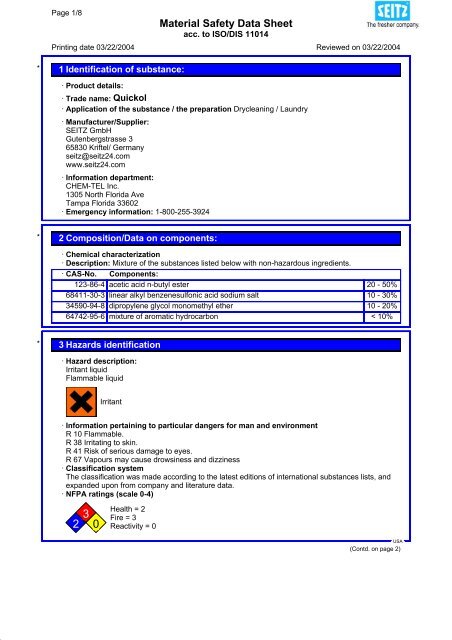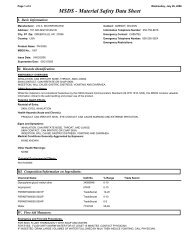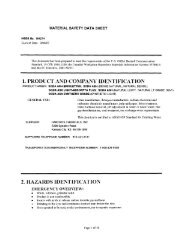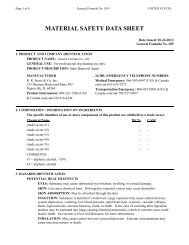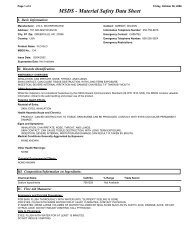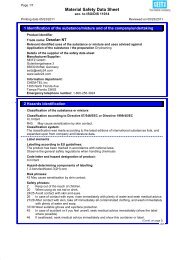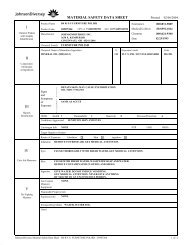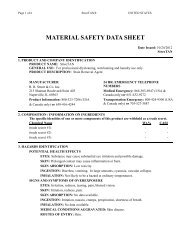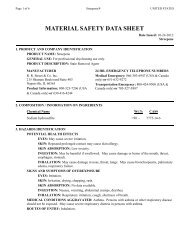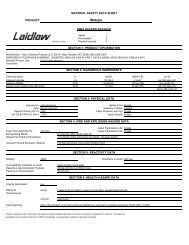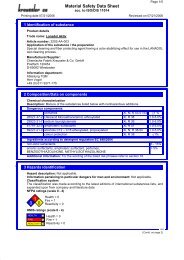MSDS Quickol - FabriClean Supply
MSDS Quickol - FabriClean Supply
MSDS Quickol - FabriClean Supply
- No tags were found...
Create successful ePaper yourself
Turn your PDF publications into a flip-book with our unique Google optimized e-Paper software.
DRPage 1/8Material Safety Data Sheetacc. to ISO/DIS 11014Printing date 03/22/2004 Reviewed on 03/22/2004* 1 Identification of substance:· Product details:· Trade name: <strong>Quickol</strong>· Application of the substance / the preparation Drycleaning / Laundry· Manufacturer/Supplier:SEITZ GmbHGutenbergstrasse 365830 Kriftel/ Germanyseitz@seitz24.comwww.seitz24.com· Information department:CHEM-TEL Inc.1305 North Florida AveTampa Florida 33602· Emergency information: 1-800-255-3924* 2 Composition/Data on components:· Chemical characterization· Description: Mixture of the substances listed below with non-hazardous ingredients.· CAS-No. Components:123-86-4 acetic acid n-butyl ester 20 - 50%68411-30-3 linear alkyl benzenesulfonic acid sodium salt 10 - 30%34590-94-8 dipropylene glycol monomethyl ether 10 - 20%64742-95-6 mixture of aromatic hydrocarbon < 10%* 3 Hazards identification· Hazard description:Irritant liquidFlammable liquidIrritant· Information pertaining to particular dangers for man and environmentR 10 Flammable.R 38 Irritating to skin.R 41 Risk of serious damage to eyes.R 67 Vapours may cause drowsiness and dizziness· Classification systemThe classification was made according to the latest editions of international substances lists, andexpanded upon from company and literature data.· NFPA ratings (scale 0-4)2 3 0Health = 2Fire = 3Reactivity = 0USA(Contd. on page 2)
DRPage 2/8Material Safety Data Sheetacc. to ISO/DIS 11014Printing date 03/22/2004 Reviewed on 03/22/2004Trade name: <strong>Quickol</strong>(Contd. of page 1)4 First aid measures· General informationImmediately remove any clothing soiled by the product.Remove casualties from exposure.Keep unprotected persons away.· After inhalation<strong>Supply</strong> fresh air. If required, provide artificial respiration. Keep patient warm. Consult doctor ifsymptoms persist.In case of unconsciousness place patient stably in side position for transportation.· After skin contactImmediately rinse with water.If skin irritation continues, consult a doctor.· After eye contactRinse opened eye for several minutes under running water. Then consult a doctor.· After swallowingRinse out mouth and then drink plenty of water.Do not induce vomiting; immediately call for medical help.· Information for doctor· The following symptoms may occur:HeadacheDizzinessDrowsinessNauseaUnconsciousness5 Fire fighting measures· Suitable extinguishing agentsCO2, extinguishing powder or water spray. Fight larger fires with water spray or alcohol resistantfoam.· For safety reasons unsuitable extinguishing agents Water with full jet.· Special hazards caused by the material, its products of combustion or resulting gases:In case of fire, the following can be released:Carbon monoxide and carbon dioxide (CO,CO2)Sulphur oxides (SOX)In certain fire conditions, traces of other toxic gases cannot be excluded.· Protective equipment:Wear self-contained respiratory protective device.Do not inhale explosion gases or combustion gases.· Additional informationCool endangered receptacles with water spray.Dispose of fire debris and contaminated fire fighting water in accordance with official regulations.6 Accidental release measures· Person-related safety precautions:Wear protective equipment. Keep unprotected persons away.Keep away from ignition sourcesEnsure adequate ventilationAvoid contact with eyes and skin.Do not breathe gases / vapors.· Measures for environmental protection:Do not allow product to reach sewage system or any water course.· Measures for cleaning/collecting:Absorb with liquid-binding material (sand, diatomite, acid binders, universal binders, sawdust).(Contd. on page 3)USA
DRPage 3/8Material Safety Data Sheetacc. to ISO/DIS 11014Printing date 03/22/2004 Reviewed on 03/22/2004Trade name: <strong>Quickol</strong>Dispose of the collected material according to regulations.(Contd. of page 2)7 Handling and storage· Handling· Information for safe handling:Keep away from heat and direct sunlight.Ensure good ventilation/exhaustion at the workplace.Ensure good interior ventilation, especially at floor level. (Fumes are heavier than air).Avoid contact with eyes and skin.· Information about protection against explosions and fires:Keep ignition sources away - Do not smoke.Protect against electrostatic charges.Protect from direct sun exposure and temperatures over 40°C.Formation of explosive vapor-/ air mixture possible.· Storage· Requirements to be met by storerooms and receptacles: Store only in the original receptacle.· Information about storage in one common storage facility:Store away from foodstuffs.Do not store together with alkalis (caustic solutions).Do not store together with oxidizing and acidic materials.· Further information about storage conditions:Store in cool, dry conditions in well sealed receptacles.Protect from frost.Time of storage: max. 12 month* 8 Exposure controls and personal protection· Additional information about design of technical systems: No further data; see item 7.· Components with limit values that require monitoring at the workplace:123-86-4 acetic acid n-butyl esterPELRELTLV710 mg/m³, 150 ppmShort-term value: 950 mg/m³, 200 ppmLong-term value: 710 mg/m³, 150 ppmShort-term value: 950 mg/m³, 200 ppmLong-term value: 713 mg/m³, 150 ppm34590-94-8 dipropylene glycol monomethyl etherPEL 600 mg/m³, 100 ppmSkinREL Short-term value: 900 mg/m³, 150 ppmLong-term value: 600 mg/m³, 100 ppmTLV Short-term value: 909 mg/m³, 150 ppmLong-term value: 606 mg/m³, 100 ppmSkin· Additional information: The lists that were valid during the creation were used as basis.· Personal protective equipment· General protective and hygienic measuresThe usual precautionary measures for handling chemicals should be followed.Keep away from foodstuffs, beverages and feed.Immediately remove all soiled and contaminated clothingDo not eat, drink, smoke or sniff while working.Wash hands before breaks and at the end of work.Do not inhale gases / vapors / aerosols.Avoid contact with the eyes and skin.(Contd. on page 4)USA
DRPage 4/8Material Safety Data Sheetacc. to ISO/DIS 11014Printing date 03/22/2004 Reviewed on 03/22/2004Trade name: <strong>Quickol</strong>(Contd. of page 3)· Breathing equipment:Not necessary if room is well-ventilated.In case of brief exposure or low pollution use respiratory filter device. In case of intensive or longerexposure use respiratory protective device that is independent of circulating air.· Protection of hands:Solvent resistant glovesThe glove material has to be impermeable and resistant to the product/ the substance/ thepreparation.· Material of glovesNitrile rubber, NBRThe selection of the suitable gloves does not only depend on the material, but also on further marksof quality and varies from manufacturer to manufacturer. As the product is a preparation of severalsubstances, the resistance of the glove material can not be calculated in advance and hastherefore to be checked prior to the application.· Penetration time of glove materialThe exact break trough time has to be found out by the manufacturer of the protective gloves andhas to be observed.· Eye protection: Tightly sealed goggles.· Body protection: Solvent resistant protective clothing* 9 Physical and chemical properties:· General InformationForm:Color:Odor:· Change in conditionMelting point/Melting range:Boiling point/Boiling range:FluidYellowishProduct specificundeterminedundetermined· Flash point: 32°C (90°F) (ASTM D 93c.c)· Auto igniting: Product is not selfigniting.· Danger of explosion: Product is not explosive. However, formation of explosive air/vapor mixtures are possible.· Density at 20°C (68°F): 0.965 - 0.975 g/cm3 (ISO 2811)· Solubility in / Miscibility withWater:· pH-value (100 g/l) at 20°C (68°F): 7.0 - 8.0Not miscible or difficult to mix10 Stability and reactivity· Thermal decomposition / conditions to be avoided:No decomposition if used according to specifications.· Dangerous reactionsReacts with strong oxidizing agents.Develops readily flammable gases / fumes· Dangerous products of decomposition: None if used as directed.USA(Contd. on page 5)
DRPage 5/8Material Safety Data Sheetacc. to ISO/DIS 11014Printing date 03/22/2004 Reviewed on 03/22/2004Trade name: <strong>Quickol</strong>(Contd. of page 4)* 11 Toxicological information· Acute toxicity:· LD/LC50 values that are relevant for classification:123-86-4 acetic acid n-butyl esterOral LD50 > 4700 mg/kg (rat)Dermal LD50 > 5000 mg/kg (rabbit)Inhalative LC50/4 h >21.0 mg/l (rat)34590-94-8 dipropylene glycol monomethyl etherOral LD50 5130 mg/kg (rat)Dermal LD50 > 19000 mg/kg (rabbit)68411-30-3 linear alkyl benzenesulfonic acid sodium saltOral LD50 2550 mg/kg (rat)64742-95-6 mixture of aromatic hydrocarbonOral LD50 >2000 mg/kgDermal LD50 >2000 mg/kg· Primary irritant effect:· on the skin: Irritant to skin and mucous membranes.· on the eye: Strong irritant with the danger of severe eye injury.· Sensitization: No sensitizing effects known.· Additional toxicological information:The product shows the following dangers according to internally approved calculation methods forpreparations:IrritantWhen used and handled according to specifications, the product does not have any harmful effectsaccording to our experience and the information provided to us.12 Ecological information:· General notes:Water hazard class 2 (Self-assessment): hazardous for water.Do not allow product to reach ground water, water course or sewage system.At present there are no ecotoxicological assessments.13 Waste Disposal Method· Product and uncleaned packagings:· Recommendation:Contaminated adsorbent, soil, water must be disposed of in a permitted hazardous wastemanagement facility. Recovered products may be reused, reprocessed or incinerated or must betreated in a permitted hazardous waste management facility. It is your duty to dispose of thechemical materials and/or their containers in accordance with the Clean Air Act, The Clean WaterAct, RCRA, as well as applicable Federal, State, and local Regulations regarding disposal.USA(Contd. on page 6)
DRPage 6/8Material Safety Data Sheetacc. to ISO/DIS 11014Printing date 03/22/2004 Reviewed on 03/22/2004Trade name: <strong>Quickol</strong>(Contd. of page 5)* 14 Transport information· DOT regulations:· Hazard class: 3· Identification number: UN1993· Packing group: III· Proper shipping name (technical name): FLAMMABLE LIQUID, N.O.S. (BUTYL ACETATES)· Label 3· Land transport ADR/RID (cross-border)· ADR/RID class: 3 (F1) Flammable liquids· Danger code (Kemler): 30· UN-Number: 1993· Packaging group: III· Description of goods: 1993 FLAMMABLE LIQUID, N.O.S., special provision640E (BUTYL ACETATES)· Maritime transport IMDG:· IMDG Class: 3· UN Number: 1993· Label 3· Packaging group: III· EMS Number: F-E,S-E· Propper shipping name: FLAMMABLE LIQUID, N.O.S. (BUTYL ACETATES)· Air transport ICAO-TI and IATA-DGR:· ICAO/IATA Class: 3· UN/ID Number: 1993· Label 3· Packaging group: III· Propper shipping name: FLAMMABLE LIQUID, N.O.S. (BUTYL ACETATES)* 15 Regulatory information (Not meant to be all-inclusive/selected regulationsrepresented)· Product related hazard informations:The product has been marked in accordance with national laws.Observe the general safety regulations when handling chemicals· Hazard symbols:Irritant(Contd. on page 7)USA
DRPage 7/8Material Safety Data Sheetacc. to ISO/DIS 11014Printing date 03/22/2004 Reviewed on 03/22/2004Trade name: <strong>Quickol</strong>(Contd. of page 6)· Risk phrases:10 Flammable.38 Irritating to skin.41 Risk of serious damage to eyes.67 Vapours may cause drowsiness and dizziness· Safety phrases:2 Keep out of the reach of children.20 When using do not eat or drink.23 Do not breathe vapour.24/25 Avoid contact with skin and eyes.26 In case of contact with eyes, rinse immediately with plenty of water and seek medical advice.27/28 After contact with skin, take off immediately all contaminated clothing, and wash immediatelywith plenty of water.37/39 Wear suitable gloves and eye/face protection.45 In case of accident or if you feel unwell, seek medical advice immediately.46 If swallowed, seek medical advice immediately and show this container or label.· National regulations· Water hazard class: Water hazard class 2 (Self-assessment): hazardous for water.· Other regulations, limitations and prohibitive regulationsThe product has been designed for professional use only.· Please note:The information herein is presented in good faith and believed to be accurate as of the effectivedate shown above. However, no warranty, express or implied is given. Regulatory requirementsare subject to change and may differ from one location to another. It is the buyers responsibility toensure that their activities comply with Federal, State or provincial and local laws. The followingspecific information is made for the purpose of complying with numerous laws and regulations.· U.S. Regulations· EPA (Environmental Protection Agency)None of the ingredients is listed.· IARC (International Agency for Research on Cancer)None of the ingredients is listed.· NTP (National Toxicology Program)None of the ingredients is listed.· TLV (Threshold Limit Value established by ACGIH)None of the ingredients is listed.· MAK (German Maximum Workplace Concentration)64742-95-6 mixture of aromatic hydrocarbon ja· NIOSH-Ca (National Institute for Occupational Safety and Health)None of the ingredients is listed.· OSHA-Ca (Occupational Safety & Health Administration)None of the ingredients is listed.· SARA Section 355 (extremely hazardous substances)None of the ingredients is listed.· SARA Section 313 (specific toxic chemical listings)None of the ingredients is listed.· Toxic Substances Control Act (TSCA):All ingredients are listed.· California proposition 65:· Prop 65 - Chemicals known to cause cancerNone of the ingredients is listed.(Contd. on page 8)USA
DRPage 8/8Material Safety Data Sheetacc. to ISO/DIS 11014Printing date 03/22/2004 Reviewed on 03/22/2004Trade name: <strong>Quickol</strong>(Contd. of page 7)· Prop 65 - Chemicals known to cause reproductive toxicityNone of the ingredients is listed.· State right-to-knowThe following product component(s)is/are cited on certain State lists as mentioned. Non-listedcomponents may be shown in the composition section of the <strong>MSDS</strong>.· CAS-No.: Chemical name: LIST:123-86-4 acetic acid n-butylester NY/PA-E34590-94-8 dipropylene glycol monomethyl ether NY/PA· OSHA hazard communication standard:This product is a "Hazardous Chemical" as defined by the OSHA Hazard CommunicationStandard, 29 CFR 1910.1200.· Comprehensive Environmental Response Compensation and Liability Act (CERCLA, orSuperfund):This product contains the following substance(s) listed as "Hazardous Substances" underCERCLA, which may require reporting of releases:· CAS-No.: Chemical name: 123-86-4 acetic acid n-butylester· Canadian regulations· WHMIS information:The Canadian Workplace Hazardous Materials Information System (WHMIS) Classification for thisproduct is:B2 - Flammable liquidD2B - Eye and/or skin irritantRefer elswhere in the <strong>MSDS</strong> for specific warnings and safe handling information. Refer to theempoyer's workplace education program.· CPR statement:This product has been classified in accordance with the hazard criteria of the Canadian ControlledProducts Regulations (CPR) and the <strong>MSDS</strong> contains all the information required by the CPR.· Hazardous products act information:This produkt contains the following ingredient(s) which are Controlled Products and/or on theIngredients Disclosure List (Canadian HPA section 13 and 14):· Canadian Ingredient disclosure list· Limit 0,1%None of the ingredients is listed.· Limit 1%123-86-4 acetic acid n-butyl ester34590-94-8 dipropylene glycol monomethyl ether68411-30-3 linear alkyl benzenesulfonic acid sodium salt16 Other information:This information is based on our present knowledge. However, this shall not constitute a guaranteefor any specific product features and shall not establish a legally valid contractual relationship.· Contact: Dr. Ralf Döring· * Data compared to the previous version altered.USA


